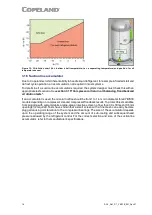
AGL_Ref_ST_YBK1E_EN_Rev01
25
For pressure control
setting, never set the low-pressure limiter to
shut off outside of the
operating envelope.
To prevent the compressor from running into problems during such
faults as loss of charge or partial blockage, the low-pressure limiter shall not be set lower
than the minimum suction pressure allowed by the operating envelope.
5.13 Minimum run time
Emerson recommends a maximum of 10 starts per hour. There is no minimum of f time because
scroll compressors start unloaded, even if the system has unbalanced pressures. The most critical
consideration is the minimum run time required to return oil to the compressor af ter start -up. To
establish the minimum run time, a sample compressor equipped with an external oil sight glass is
available f rom Emerson. The minimum on time becomes the time required f or oil lost during
compressor start-up to return to the compressor sump and to restore a minimal oil level that will
ensure oil pick-up through the crankshaft. Cycling the compressor for a shorter period than this, for
instance to maintain very tight temperature control, will result in progressive loss of oil and damage
to the compressor.
5.14 Shut-off sound
Scroll compressors incorporate a device that minimizes reverse rotation. The residual momentary
reversal of the scrolls at shut-off can cause a clicking sound. It is entirely normal and has no effect
on compressor durability.
5.15 Supply frequency and voltage
There is no general release of standard Copeland scroll compressors for use with variable speed AC
drives. A number of considerations must be taken into account when applying scroll compressors
with variable speed, including system design, inverter selection, and operating envelopes at various
conditions. Only frequencies f rom 50 to 60 Hz are acceptable. Operation outside this frequency range
is possible but should not be done without specific Application Engineering review. The voltage must
vary proportionally to the frequency.
If f or example, the inverter in a 3-phase system can only deliver a maximum voltage of 400 V, the
amps will increase when the speed is above 50 Hz, and this may give rise to nuisance tripping if
operation is near the maximum power limit and/or compressor discharge temperature limit.
The last letter of the motor code indicates which f requency and voltage must be appli ed
– see
section 2.2
"
Error! Reference source not found.
"
.
50 Hz
Code
220-240 V / 1 ph
Z
380-420 V / 3 ph
M
Table 12: Electrical codes for motors
5.16 Oil level
Some systems may contain higher than normal ref rigerant charges. Systems with large coils, low
ambient condenser f looding, or systems with multiple heat exchangers are among some system
conf igurations that may require additional lubricant.
There is no oil sight glass on YB*K1E compressors.
During the system development phase, adequate oil return f rom the system to the compressor should
be evaluated and qualified. For this purpose, a sample compressor for lab testing, equipped with an
external oil sight tube, is available from Emerson. See also information in
section 3.15 "Compressor
oil return, oil balancing, floodback and oil dilution tests".
If an oil regulator is used the oil level should be set within the top half of the oil regulator sight glass.
BOM version GCG contains a stub tube connection 7/8" (22.2 mm) for paralleling on the compressor
housing at oil level height.









































